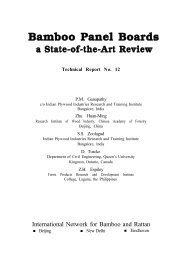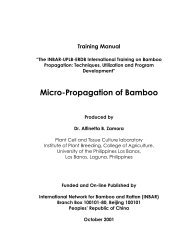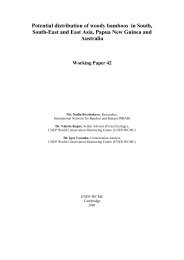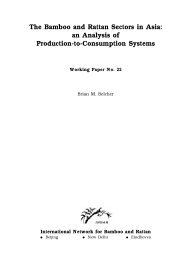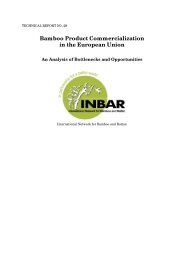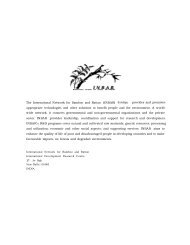ISSN ………… - International Network for Bamboo and Rattan
ISSN ………… - International Network for Bamboo and Rattan
ISSN ………… - International Network for Bamboo and Rattan
You also want an ePaper? Increase the reach of your titles
YUMPU automatically turns print PDFs into web optimized ePapers that Google loves.
the desired pulp type <strong>and</strong> quality. Defibration is carried out by means of single or multi-stage<br />
refinement process using disk refiners.<br />
The lignin content of the NSSC pulps is high as compared to those from chemical pulps, <strong>and</strong> ranges<br />
between 10 <strong>and</strong> 15 per cent. Due to the high lignin <strong>and</strong> polyoses content the NSSC pulp has low<br />
conventional strength properties. The typical NSSC pulp is normally much more rigid <strong>and</strong> stiff than<br />
kraft pulp. There<strong>for</strong>e, it is the most typical <strong>and</strong> suitable fibre material <strong>for</strong> the production of<br />
corrugating medium.<br />
The caustic soda in the soda semichemical process reacts with the lignin-carbohydrate complex to<br />
<strong>for</strong>m soluble sodium lignate, <strong>and</strong> the carbohydrates are solubilized by hydrolysis. However, this lignin<br />
reaction occurs only after a major portion of the caustic soda has been consumed in neutralizing the<br />
readily available acetyl <strong>and</strong> methoxyl groups <strong>and</strong> in hemicellulose dissolution. There<strong>for</strong>e, lignin<br />
removal is the least in alkaline semichemical pulping.<br />
The cold-soda or cold caustic process, which is less important than the NSSC process, involves in<br />
principle, the treatment of chips with a sodium hydroxide solution at temperatures generally between<br />
20 <strong>and</strong> 30 0 C <strong>and</strong> a final refiner defibration. In the cold-soda chemimechanical pulping, the caustic<br />
soda attacks the fibre bond mainly by reaction with the acetyl <strong>and</strong> other acid groups, which are<br />
reactive even at room temperature. The most important step in the cold-soda pulping is the<br />
impregnation with alkaline liquor to reach a very fast but total penetration of the chips, causing the<br />
necessary swelling of fibres <strong>and</strong> avoiding considerable losses of polyoses. Impregnation times are<br />
between 15 <strong>and</strong> 120 minutes with generally short reaction times of 15-30 minutes in pressurized <strong>and</strong><br />
continuous systems. The concentrations of NaOH are generally low (0.25–2.5%), but up to 10 per<br />
cent in the case of some roller mill impregnation systems. Cold-soda pulping requires little installation<br />
capital, <strong>and</strong> despite the cost of the chemicals, the processing costs are actually lower than in stone<br />
grinding, because of reduced energy consumption. In some process modifications the liquor is reused<br />
up to 20 times.<br />
The cold-soda pulp yield ranges between 85 <strong>and</strong> 92 per cent, whereby the selectivity of lignin <strong>and</strong><br />
polyoses dissolution is much lower than NSSC pulping. The main disadvantage of cold-soda pulps is<br />
a generally a low brightness level (40-50%), which can be effectively increased by a two-stage<br />
peroxide-hypochlorite bleaching.<br />
As the cold-soda pulps have properties comparable to NSSC pulps, these are used as unbleached<br />
coarse grades <strong>for</strong> corrugating medium production, <strong>and</strong> as bleached grades <strong>for</strong> printing papers <strong>and</strong><br />
newsprint in combination with groundwood pulp <strong>and</strong> chemical pulp.<br />
13



